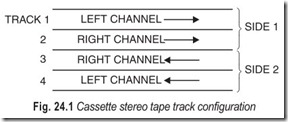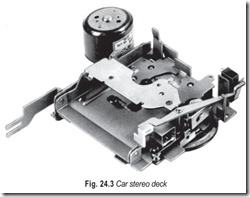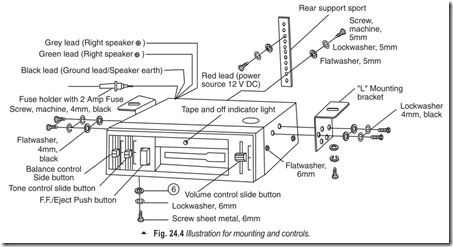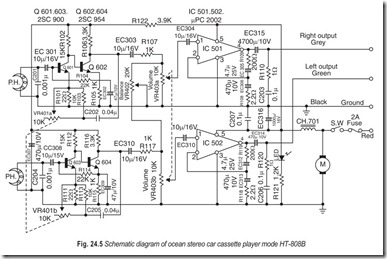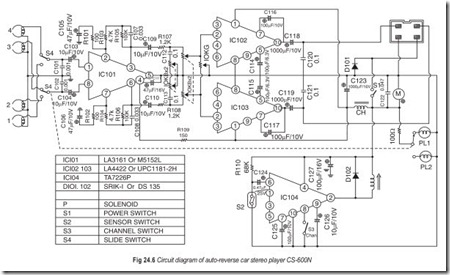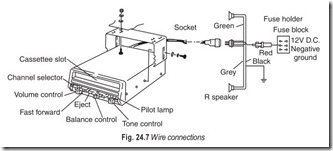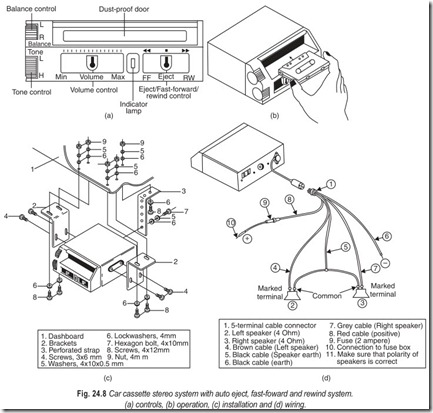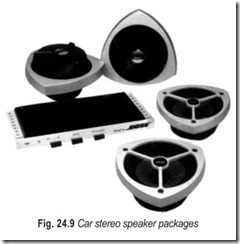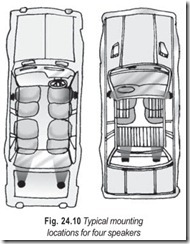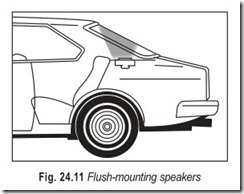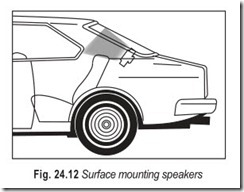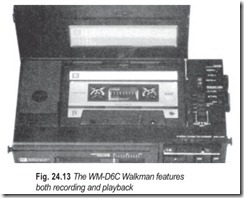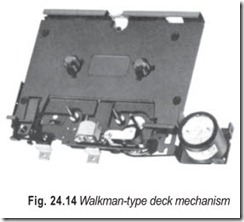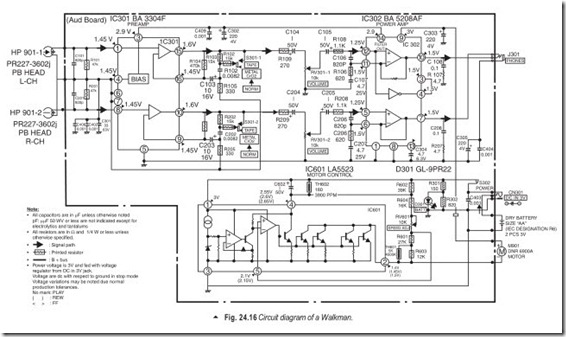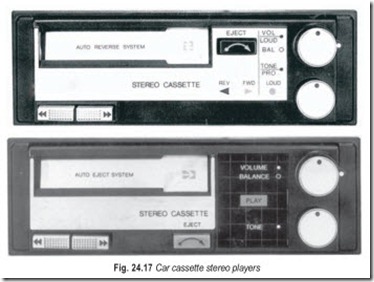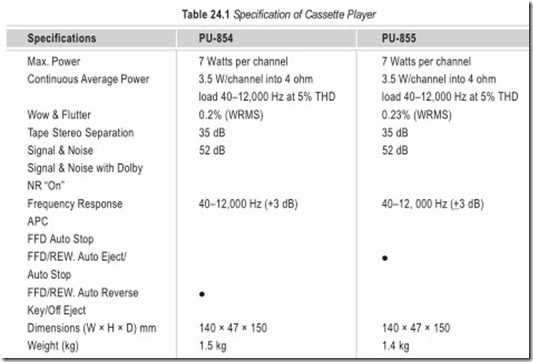PORTABLE STEREO
Since many of us spend an increasingly larger portion of our available time travelling, the desire for on-the-road entertainment has increased tremendously. The cassette tape player was originally designed for home and office use rather than for the automobile. It was developed to satisfy the needs of those who required a simple, portable recording device. So the cassette recorder came into being. It is simple to operate, reasonably priced, has good fidelity and, above all, is very portable and compact. Since the environment intended for the cassette device did not initially include the automobile, it is understandable that a similar device, the eight-track system, undergoing development at about the same time but more compatible with the automobile market, gained widespread acceptance.
EIGHT-TRACK SYSTEM
The eight-track system, although somewhat physically larger, is portable and easy to use. It performs well and is usually less expensive than the cassette. The eight-track stereo tape cartridge, with its endless tape, is suitable for the special conditions found in the automobile. The system requires little attention on the part of the operator other than setting the sound level, tone, and balance controls. The cartridge, once inserted into the transport mechanism will continue to play all of the program material continuously until ejected.
The greatest detractor of the eight-track player seems to centre around the fact that the operator cannot “slew” the tape to a preferred selection. Some manufacturers do provide a fast-forward control which will allow the operator to advance the tape, but none incorporates a rewind or reverse capability. Therefore, the user must either wait for a particular selection to appear, or he may depress the program selection switch as required until he reaches the desired material. This, no doubt, leaves something to be desired.
Originally, the cassette transport, drive system housing, and cartridge were designed and ultimately produced with compactness as a first requirement. The very reduction in size alone required smaller mechanical parts, which, in turn, resulted in tighter allowable tolerances and greater precision in operation. The cassette player, therefore, is a little more susceptible to undesirable environmental conditions than the eight-track player. Temperature extremes as well as rough road conditions can have a noticeable effect on performance.
Eight-track cartridge tapes are operated at 3¾ ips and are 0.250 inch wide, upon which four programs are recorded. The material is recorded as left and right channels for each of the four programs resulting in eight tracks. This is illustrated in Fig. 24.1
Early systems left little discussion open with regard to performance. Open reel-to-reel devices, for many obvious reasons, are impractical for use in the automobile. The eight-track cartridge units provide good playback response primarily because of the speed at which the tape runs. Early cassette units were plagued with a limited high-frequency response, generally characterised by a high hiss level, frequent tape dropouts, and often audible flutter. Eight-track stereo tape configuration is illustrated in Fig. 24.2
The tape condition called dropouts is a problem encountered with any tape system. A dropout consists of a very small section of tape where for some reason no signal has been recorded, or no replay is picked up.
The cause may be a small piece of dirt on the tape, or, more usually a slight unevenness of the surface. Very often a dropout may occur in one channel only. Most high quality tapes are polished to minimise dropouts, but an additional polishing before playing can be helpful, and is most useful if the tape is not of the highest quality. The polishing operation consists simply of running the tape through the machine so that the tape rubs against the head and any high spots are rubbed down and any dirt spots removed. Insert the cassette, select the play key, and run each half of the tape through the machine. It is an advantage to run several tapes through in this way if the tapes need this treatment, and then clean the heads using a head cleaning tape. After polishing, the tape may be recorded and used in the usual way.
Progress in reducing these undesirable characteristics of the cassette system has been rapid. Cassette record and playback devices today have an extended frequency response upto 15 kHz. Tape manufacturers have developed low noise tapes and cartridge design has virtually eliminated tape dropout, even with bulky tape cartridges. Cassette transport devices have undergone vast improvements, that have reduced the flutter problem.The low noise chromium dioxide (CrO2 ) tapes enhance the sounds recorded by offering a low noise level, coupled with high-frequency response than other tape types previously available to the automobile stereo enthusiast.
Dolby B, a new technology in the cassette recording world, has given the recorded tape a performance level bordering on extremely good fidelity. The Dolby circuit boosts the high-frequencies, principally above several kilohertz, during recording and then reduces them in a complementary fashion for playback. At high signal levels, the circuit has no effect and frequency response is totally unaffected by the Dolby action. The subsequent boost and cut, which is instantaneous and completely undetectable, varies with the recording level. The net result is a vast improvement in the signal to noise ratio which the listener recognises as a dramatic reduction in background hiss and distortion. The net effect of these combined improvements has been to lift the cassette system out of its ‘also ran’ category into one of respectable contention in the high fidelity community.
Some additional features offered by manufacturers of tape players include fine tuning on eight-track units, which gives the user the ability to adjust the tape head for precise alignment with the pre-recorded tapes. This ability to tune out undersirable cross talk due to misalignment can some times mean the difference between enjoyment and distracting discord.
Another feature being offered is automatic reverse which allows the program material to be played without the need to eject, turnover, and reinsert the cassette.
Other features currently available include anti-theft devices such as magnetic locks and guard circuits which activate the automobile horn when the tape unit is removed. A typical car stereo deck is shown in Fig. 24.3.
OCEAN STEREO CAR CASSETTE PLAYER MODEL HT-808B
(see Figs. 24.4 and 24.5)
Specifications:
1. Player System : 4-track, 2-channel stereo
2. Tape Speed : 4.75 cm/s
3. Wow & Flutter : 0.35 WRMS
4. Output Power : 4.5 W/channel
5. Freq. Response : 50 Hz-10,000 Hz
6. Distortion : Less than 3%
7. Semi-conductor : 4 Transistors, 2 ICs
8. Power Source : 12V DC, Negative Earth
9. Channel separation : More than 30 dB
10. Dimensions : Depth 147, Width 138, Height 42 (mm)
11. Load Impedance : 8 Ω
12. Weight : 0.86 kg approx.
13. Signal to noise ratio : More than 40 dB
Installation :
* This unit is suitable for 12 volt negative earth cars.
* Install the unit under the dashboard or in a location that will not hinder your driving, but close enough to operate the player easily.
Fig 24.4 shows one of typical ways of mounting.
1. Drill three 7/32” holes in a location where you want to install the unit, and tighten the mounting bracket with screw and washers provided.
2. Then, install the unit on the mounting brackets with bolts furnished. Do not use any bolts other than the ones provided with the unit, to prevent circuit damage.
AUTO-REVERSE CAR STEREO PLAYER CS-600N
(See Fig. 24.6 and 24.7)
Specifications :
Tape Standard Cassette
Tape speed 4.75 cm/s (17 8 ips)
Output load 4 Ω or 8 Ω Speakers
Power source DC 13.2V (10.5 ~ 15 V) negative grounded
Frequency response 33 ~ 10,000 Hz
Output power 8 watt per channel (max.)
Wow & flutter Less than 0.2%
Cross talk More than 40 dB
Channel (max.) separation More than 30 dB
Signal-to-noise ratio More than 45 dB
Distortion Less than 10% at 5.5 W per channel (max.)
Current drain 350 mA at no signal, 1.7A at max. output, 2.5 A at channlel (max.) selection
Net Weight 1.5 kg
Dimensions 48 (H) × 120 (W) × 166 (D) mm.
Tape running light
Slide volume, Balance control, and Tone control
* High-Quality stereo sound
* Play autostop
Features : This highly compact Auto Reverse Car Cassette Stereo Player has been carefully engineered to conveniently and reliably provide you with concert quality stereo listening pleasure. It incorporates all the luxurious features and performance only found on the finest car cassette players. The entirely new and exclusive mechanism, ensure years of troubled-free performance.
* Operates in any car, truck, boat or plane with a 12 volt dc negative system, even with extremely limited space available under the dash board.
* Automatic Reverse System allowing continuous tape play.
* Extremely simplified mechanism using no rubber belt for reel drive ensures years of trouble-free performance.
* Provided with Fast Forward and Rewind Push buttons which lock up for convenience.
* Light-touch Eject Push button incorporated with the exclusive simplified cassette pop out mechanism.
CAR CASSETTE STEREO PLAYER WITH AUTO EJECT AND FAST-FORWARD REWIND SYSTEM
(see Fig. 24.8)
Specifications :
1. Cassette used : Compact (Philips) type
2. Voltage : 12 Volt (11 – 16 V)
3. Current : 1.5 Amp.
4. Tape speed : 17/8 ips
5. Output Power : 2 × 7 W
6. Speaker impedance : 4 ohm
7. Frequency range : 50–10,000 Hz
8. Signal to noise ratio : 40 dB
9. Weight : 1.1 Kg
10. Dimensions : 48 (H) × 130 (W) × 161 (D) mm
SPEAKERS
The common (or may be not so common) denominator in all sound systems is the speaker. If the input is technically good and the output to the speakers is pleasing, how disappointing the result if speaker performance is less than desirable just because of poor performance. Most of the speakers are designed to handle power in the 6 to 8 W range. From that point on, however, similarities begin to flatten out.
Car stereo speakers, Fig. 24.9 come in all sizes, shapes and impedances; round, oval, miniature, slim-line, air suspension, wedge, 4 W, 8 W, 3 inch, 4 inch, 10 inch, etc. The main point in all this is that in order for the total system to be most effective, the speakers must match the system as well as the application. In addition, they must be able to exist and perform in an adverse environments.
Some manufacturers cognizant of this condition, offer packages which include the speakers. The systems shown in Fig. 24.10 are representative examples. Speaker manufacturers, also offer enclosures, complementary both to decor and to environment. Some offer so called “convertibles” which may be flush-mounted in doors on panels. Others are designed for hidden installation under the rear deck of front dash panel, as well as surface mounting. It is not unusual to find speakers capable of handling 20 W or more of music power. It is also interesting to note that magnet weights vary from less than two ounces to over twenty ounces. Frequency response ranges may vary in the bass and treble areas from 50 Hz to 12 kHz.
Speaker mounting and speaker location is important. Particularly important is speaker location relative to both passenger(s) and driver.
There are many ways to instal speakers in an automobile. A minimum of two speakers is required for stereo and the suggested locations are at the left and right front areas of the automobile. If your speakers are installed for a better stereo effect, two speakers are placed in the front area of the vehicle and two in the back, as shown in Fig. 24.10.
Most manufacturers suggest that placing the speakers in the car doors provides the best baffling effect for optimum frequency range. If the speakers are installed in the doors, however, some consideration should be given to protecting them from moisture. A few flush-mount speaker kits come equipped with a moisture shield for door installation as shown in Fig. 24.11.
In addition to the flush-mounting type of speakers used in doors and rear deck areas, there are many surface mounting speakers and baffles see Fig. 24.12. Some surface mounting speaker systems also have adhesive pads which allow them to be placed on a flat surface without drilling. This can be a definite advantage in areas where screws cannot be easily installed or for use in temporary installations.
Unlike your audio room at home, your car’s interior is of a more complex design. The size, shape and density of the seats, doors, carpets, roof and glass areas, all affect the acoustic properties of the vehicle. A multi-speaker system, correctly installed and effectively positioned, will maximise sound reproduction in your car.
Installing flush mounted speakers on the rear parcel shelf is particularly advantageous for bass reproduction as the boot functions as a speaker enclosure. To obtain maximum benefit, install speakers with the largest possible diameter. A.W.A. Clarion speakers range from 10 cm to 16 cm diameter, from single cone to traixes, from 12 watt to 60 watt power speaker handling capacity.
Placing surface mounted speakers on the rear parcel shelf gives least installation problems. Be careful, however, not to install them too close to the back seat as this will obstruct the flow of sound and muffle it. Place them as far back as possible and adjust the angle so that sound can flow forward smoothly. To increase three-dimensional sound effect, place the speaker as far apart as possible. The A.W.A. Clarion range includes two-way speaker system featuring acoustic lenses and sealed box baffles.
WALKMAN
Stereo players offer new dimensions to portable stereo sound. Walkman is a slim-line mini stereo player with headphones, see Fig. 24.13.
Walkman type mini-cassette deck mechanisms are commercially marketed. A typical deck is illustrated in Fig. 24.14.
DC Micromotors for Walkman type and other cassette tape recorders are illustrated in Fig. 24.15. Four track, four channel magnetic tape heads for mono and stereo, are also illustrated in Fig. 24.15.
Circuit diagram of a typical Sony Walkman is given in Fig. 24.16.
Mini-cassette (Walkman-type assembly) Specifications:
Operating conditions horizontal or vertical Wow & flutter: 0.3% WRMS
Life: 500 hours
Dimenstions: 133.5 × 84.5 × 25.1 mm Weight: 200g.
Cassette player and stereo headphones bring full reproduction of stereo tapes. Music with superlative sound quality is now available anywhere, indoors or outdoors, at any time. You can enjoy hi-fi stereo sound, everywhere.
Piezo headphones usesamarian cobalt and other new materials in order to make them virtually weightlesss and they are designed according to ‘Just Fit Ear’ method that gives such a perfect and comfortable fit that you won’t even know you have them on. Further they provide such a natural sound quality that you will not tire even after long hours of listening.
Fig. 24.17 and 24.18 depict respectively “AWA Clarion car cassette stereo players” and “Philips personal stereo cassette player” – DS781.
Technical Data Cassette Section
Cassette System : Compact Cassette
Cassette tape : All types
Motor : DC, electronic control
Tape speed : 4.76 cm/sec standard
Wow and flutter : 0.21% WRMS
Heads : Playback head Signal-to-noise ratio : 45 dB
Track separation : 50 dB
Amplifier Section
Peak Power Output
(+ 1 dB. D < 10%) : 2 × 20 mW
Connections
Stereo headphones : 3.5 mm socket Power Supply Batteries : 2 × 1.5 V (type R 6) DC : 3 V
Cabinet
Dimension
Fig. 24.18 Philips personal stereo cassette player–DS781
(W × H × D) : 123 × 98 × 35 mm approx.
Weight : 0.2 kg.
Accessories : Stereo headphones supplied
EXERCISES
Descriptive Questions
1. What are the essentials of portable stereo?
2. In what sizes, shapes and impedance do car stereo speakers come?
3. Speaker mounting and speaker location, relative to both passengers and driver, is important. Explain.
4. What are the typical mounting locations for car stereo speakers?
Fill in the Blanks
1. A dropout consists of a very small section of tape where for some reason no signal has been……………………………….. or no ……………………………….. is picked up.
2. Cassette record and playback devices today have an extended frequency response upto……………………………….. .
3. Chromium dioxide tapes enhance the sounds recorded by offering a……………………………….. noise level.
4. The Dolby circuit boosts the high frequencies during recording and then reduces them in a ……………………………….. fashion for play back.
5. Automatic reverse allows the program material to be played……………………………….. the need to eject, turnover and……………………………….. the cassette.
6. Magnetic locks and guard circuits ……………………………….. the automobile horns when the tape unit is removed.
7. The common denominator in all sound circuits is the…………………………………
8. In order for the total system to be most effective the speakers must……………………………….. the system as well as the application.
9. Walkman is a slim line mini stereo player with……………………………….. .
ANSWERS
Fill in the Blanks
|
1. recorded, replay |
2. 15 kHz |
3. low |
|
4. complementary |
5. without, reinsert |
6. activate |
|
7. speaker |
8. match |
9. headphones |
